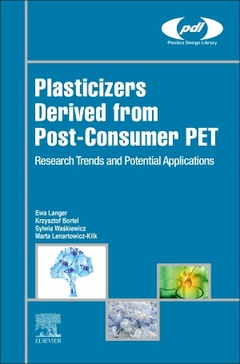Plasticizers Derived from Post-consumer PET Research Trends and Potential Applications Plastics Design Library Series
Auteurs : Langer Ewa, Bortel Krzysztof, Lenartowicz-Klik Marta, Waskiewicz Sylwia

Plasticizers Derived from Postconsumer PET: Research Trends and Potential Applications presents a roadmap to the successful use of postconsumer PET to obtain plasticizers for later use, a proposal which presents both economic and sustainability advantages. Based on the results of the latest research into the development of chemical recycling techniques of PET waste, this book describes techniques where the plasticizer obtained can be utilized for value addition in PVC and other polymers.
In addition, the book provides basic introductory information on the role of plasticizers in the modification of polymers, basic quality requirements, and the latest trends in the synthesis and use of plasticizers in industry, also presenting the available methods of PET recycling, with particular emphasis on chemical recycling, analysis of the PET market, the availability of postconsumer PET, and its value as a raw material for other products.
Based on the authors? research, the book discusses the use of postconsumer PET in the synthesis of monomeric and oligomeric plasticizers. Synthesis conditions are shown in detail, and the influence of the structure of synthesized softeners on their basic quality parameters are assessed and compared with selected commercially available products. In the final sections, the book covers the economic challenges and benefits of this process and its application to newly developed products.
- 1 Assessment of Traditional Plasticizers............................................1
- 1.1 General Characteristic of Plasticizers ..........................................1
- 1.2 De?nitions....................................................................................2
- 1.3 Role of Plasticizers in Plastic Processing ......................................4
- References.........................................................................................10
- 2 Classi?cation of Plasticizers............................................................ 13
- 2.1 Introduction.................................................................................13
- 2.2 Monomeric Plasticizers...............................................................22
- 2.3 Extenders....................................................................................28
- 2.4 Polymeric Plasticizers.................................................................29
- 2.5 Other Plasticizers........................................................................38
- References........................................................................................39
- 3 Essential Quality Parameters of Plasticizers..................................45
- 3.1 Basic Quality Parameters............................................................45
- 3.2 Speci?c Quality Parameters........................................................64
- 3.3 Antiplasticization........................................................................87
- References........................................................................................93
- 4 Research Trends in Plasticizer Production...................................101
- 4.1 Petrochemical Alternatives.......................................................103
- 4.2 Plasticizers Manufactured from Renewable Raw Materials.............111
- References.........................................................................................119
- Further Reading................................................................................126
- 5 Methods of PET Recycling ........................................................... 127
- 5.1 Chemical Recycling..................................................................129
- 5.2 Mechanical Recycling...............................................................159
- 5.3 Energetic Recycling..................................................................162
- References.........................................................................................163
- 6 Synthesis of Plasticizers From Postconsumer PET.................... 173
- 6.1 Introduction...............................................................................173
- 6.2 Synthesis of Monomeric Plasticizers .......................................179
- 6.3 Synthesis of Oligomeric Plasticizers........................................184
- References.........................................................................................193
- 7 Application of New, Synthesized Plasticizers.............................. 195
- References.........................................................................................210
- Index ..................................................................................................... 213
Producers of plasticizers and other plastic additives. Processors of plastics using PET-derived plasticizers. Scientists in R&D working on new applications for PET-derived plasticizers
Krzysztof Bortel is the Director of the Institute For Engineering Of Polymer Materials and Dyes Paint and Plastics at the Silesian University of Technology in Gliwice.
Marta Lenartowicz-Klik gained her Ph.D. at the Faculty of Chemistry, Silesian University of Technology (2006). She works at the Department of Physical Chemistry and Technology of Polymers of Silesian University of Technology.
Sylwia Waskiewicz works in the Institute For Engineering Of Polymer Materials & Dyes Paint & Plastics at the Silesian University of Technology in Gliwice, primarily in the areas of plastics modification and processing, particularly in poly(vinyl chloride).
- Presents a step-by-step introduction to the methods of recycling PET into usable plasticizers
- Provides a viable, actionable alternative to landfills for postconsumer PET, enabling the recycling of more waste polymer and reducing the carbon footprint of PET
- Analyzes the economic benefits and challenges of this process
- Compares the quality of the output to commercially available products
Date de parution : 11-2019
Ouvrage de 228 p.
15x22.8 cm



